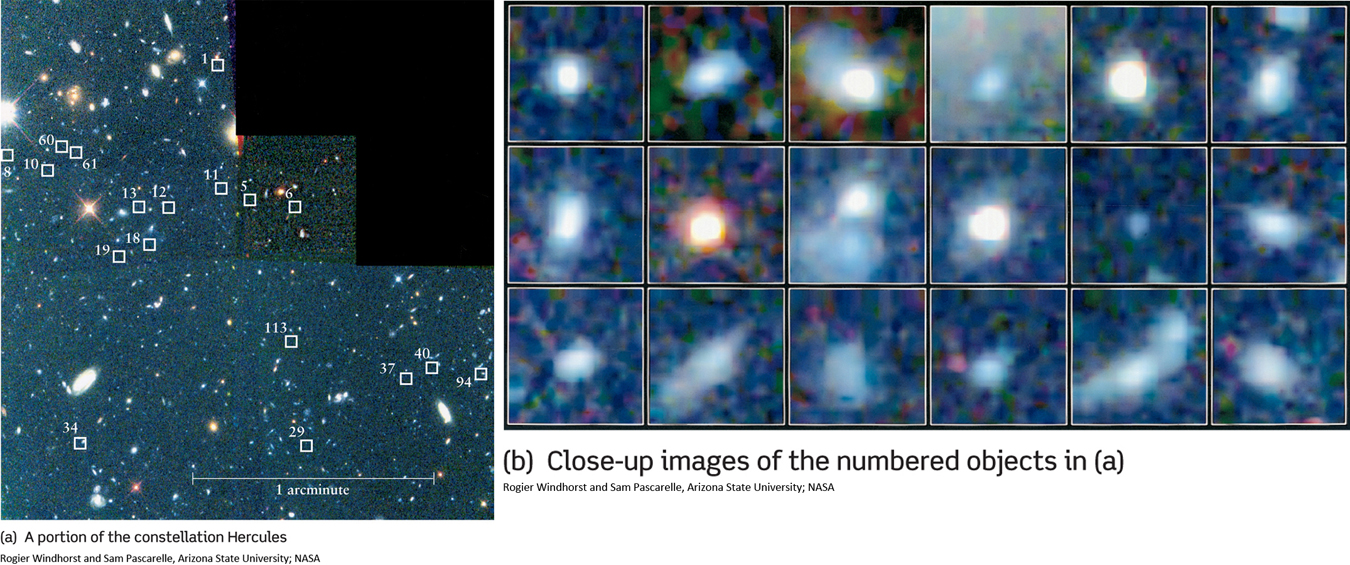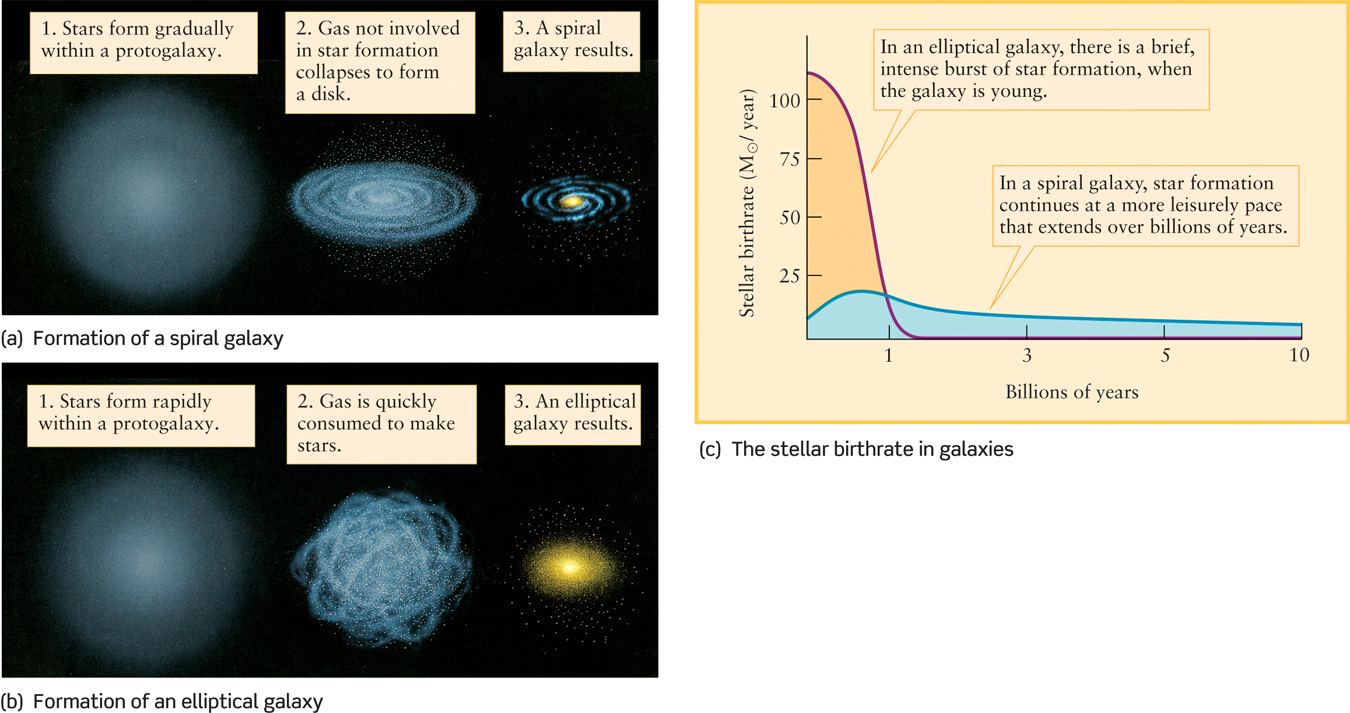14-9 Galaxies may have formed from the merger of smaller objects
How do galaxies form and how do they evolve? Astronomers can gain important clues about galactic evolution simply by looking deep into space. The more distant a galaxy is, the longer its light takes to reach us. The Andromeda Galaxy is 2.2 million ly away from us, which means that the light we see from it tonight left Andromeda 2.2 million years ago. We are in effect looking into Andromeda’s past. As we examine galaxies that are at increasing distances from Earth, we are actually looking further and further back in time. By looking into the past, we can see galaxies in their earliest stages.
Building Galaxies from the “Bottom Up”
The Hubble Space Telescope images in Figure 14-34 provide a glimpse of galaxy formation in the early universe. Figure 14-34a shows a number of galaxylike objects some 11 billion ly away and are thus seen as they were 11 billion years ago. These objects are smaller than even the smallest galaxies we see in the present-day universe and have unusual, irregular shapes (Figure 14-34b). Furthermore, these objects are scattered over an area only 2 million ly across—less than the distance between the Milky Way Galaxy and M31—making it quite probable that they would collide and merge with each other. These collisions would be aided by the dark matter associated with each subgalactic object, which increases the object’s mass and, hence, the gravitational forces pulling the objects together. Such mergers would eventually give rise to a normal-sized galaxy.
Images such as those in Figure 14-34 lead astronomers to conclude that galaxies formed “from the bottom up”—that is, by the merger of smaller objects like those in Figure 14-34b to form full-size galaxies. (These same images rule out an older idea that galaxies formed from the “top down”—that is, directly from immense, galaxy-sized clouds of material.) The blue color of the objects in Figure 14-34b indicates the presence of young stars. Observations indicate that the very first stars formed about 13.5 billion years ago, when the universe was only about 200 million years old.

352
Question
ConceptCheck 14-19: Did today’s galaxies form from combining smaller galaxies or from the separation of larger galaxies?
Forming Spirals, Lenticulars, and Ellipticals
 Go to Video 14-6
Go to Video 14-6
Once a number of subgalactic units combine, they make an object called a protogalaxy. The rate at which stars form within a protogalaxy may determine whether this protogalaxy becomes a spiral or an elliptical. If stars form relatively slowly, the gas surrounding them has enough time to settle by collisions to form a flattened disk, much as happened on a much smaller scale in the solar nebula during the formation of our Sun and solar system. Star formation continues because the disk contains an ample amount of hydrogen from which to make new stars. The result is a spiral galaxy (Figure 14-35a). But if stars initially form in the protogalaxy at a rapid rate, virtually all of the available gas is used up to make stars before a disk can form. In this case what results is an elliptical galaxy (Figure 14-35b).
Galaxies change shape when gravitationally distorting other galaxies.
Figure 14-35c compares the stellar birthrate in the two types of galaxies. This graph helps us understand some of the differences between spiral and elliptical galaxies that we described earlier. Protogalaxies are thought to have been composed almost exclusively of hydrogen and helium gas, so the first stars were Population II stars with hardly any metals (that is, heavy elements). As stars die and form planetary nebulae or supernovae, they eject gases rich in metals into the interstellar medium. In a spiral galaxy, there is ongoing star formation in the disk, so these metals are incorporated into new generations of stars, making relatively metal-rich Population I stars like the Sun. By contrast, an elliptical galaxy has a single flurry of star formation when it is young, after which star formation ceases. Elliptical galaxies therefore contain only metal-poor Population II stars.
Figure 14-35c shows that both elliptical and spiral galaxies form stars most rapidly when they are young. This idea is borne out by the observation that very distant galaxies tend to be blue, which means that galaxies were bluer in the distant past than they are today. (Note the very blue colors of the distant, gravitationally lensed galaxies shown in Figure 14-27c, as well as those of the subgalactic objects shown in Figure 14-34b.) Spectroscopic studies of such galaxies in the 1980s by James Gunn and Alan Dressler demonstrated that most owe their blue color to vigorous star formation, often occurring in intense, episodic bursts. The hot, luminous, and short-lived O and B stars produced in these bursts of star formation give blue galaxies their characteristic color.

Question
ConceptCheck 14-20: Why do elliptical galaxies contain only Population II stars?
353
An Evolving Universe of Galaxies
In addition to changes in galaxy colors, the character of the galactic population has also changed over the past several billion years. In nearby rich clusters, only about 5% of the galaxies are spirals. But observations of rich clusters at distances corresponding to looking about 4 billion years into the past show that about 30% of their galaxies were spirals.
Why were spiral galaxies more common in rich clusters in the distant past? Galactic collisions and mergers are probably responsible. During a collision, interstellar gas in the colliding galaxies is vigorously compressed, triggering a burst of star formation. A succession of collisions produces a series of star-forming episodes that create numerous bright, hot O and B stars, which become dispersed along arching spiral arms by the galaxy’s rotation. Eventually, however, the gas is used up; star formation then ends and the spiral arms become less visible. Furthermore, tidal forces tend to disrupt colliding galaxies, strewing their stars across intergalactic space until the galaxies are completely disrupted (see Figure 14-24).
A full description of galaxy formation and evolution must include the effects of dark matter. As we have seen, only about 10% of the mass of a galaxy—its stars, gas, and dust—emits detectable light of any kind. As yet we have no idea what the remaining 90% looks like or what it is made of. The dilemma of dark matter is one of the most challenging problems facing astronomers today.
Question
ConceptCheck 14-21: What happens to spiral galaxies during galaxy mergers?